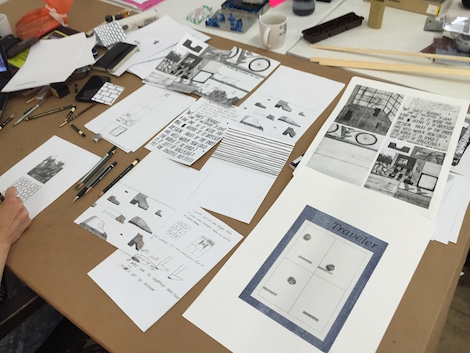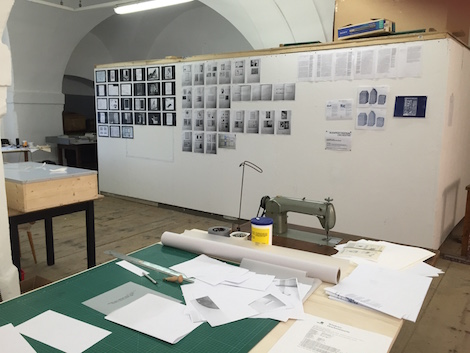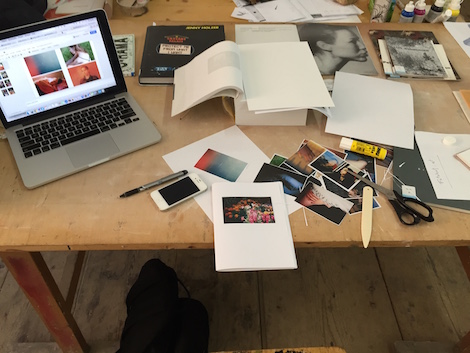| « 13 / 30 Public Routines | 11 / 30 Grounded Lions » |
12 / 30 Dummies - no thinking without objects
The first dummies are finished. You can see them on every table in Bernhard Cella’s artist book making class. Observing the class for the past week I am still amazed by the speed in which they produce their ‘dummies’: little semi-finished booklets somewhere between a prototype and an experimental byproduct. Whenever Bernhard Cella and his co-teacher Anton Stuckardt are not in conversation with students, they are working on their own dummies, too.
“I will also work on something. I want to create a studio situation where everybody works on something they are interested in. With their questions and what they are interested in unlike in a school situation.”
“So what are you going to work on?”
“I am going to do exactly the same exercises that you are doing. When I work with a group it is important to me to work, too. It is a completely different experience. I can watch you working, but you can also watch me working and then we can get into conversation.”

Throughout the course each participant will create two books. The first task was to select a book from the academy’s library and make a book about this book. The exercise should give a feeling for the medium and its possibilities and limitations. What is the book about? What are you interested in when selecting it? How do you construct and re-construct it? The second book will be based on materials were collected before the course. Between two conversations with students I catch Bernhard Cella for a conversation on dummies, content and doing things yourself.
What is important to you when you are teaching?
Often when I meet students from art academies, they can tell me a lot about art, but they barely have a clue how you make art. Learning to make art is not about learning some technique like life drawing. It is about perception, experiences and forms of work that cannot be conveyed in a technical language. Instructions like ‘you have to do this’ or ‘this is how it is done’ don’t work. Rather than that learning art has to do with reflection and with a particular headspace. Only if you are confronted with a headspace, with some kind of void you have to fill, you start to ask the right questions. One of my teachers at Vienna Art Academy when I was a student gave me the instruction: ‘work in this room for a week and do something and after one week we meet again.’ He would leave the question what to do entirely to you. So you had to produce content and to deal with the question: what is my content? It gets really interesting when you start to wonder: what are the things that really concern me? Do they have some kind of relevance?
How do these considerations inform your teaching?
It is really important to me that in my classes there is a balance between different kinds of movements. Firstly, the students have to move themselves. I don’t influence this, they all come with their own skills and projects. This focuses on the questions: what did you bring with you? At which point are you at the moment in work? And how can you develop that further? Another kind of movement is confrontation. We present techniques and the processes in which books are made, from the first concept until the finished publication. And thirdly, there is one concrete task that gives people a problem that they have to deal with. It is not so important to have perfect publication at the end, but to start producing. Our exercise was to make a book about a book. The idea here is not to produce some kind of review, but to come to a reaction to the book with one’s own means. The question how to do it yourself is also important to me. As an artist you want to be able to carry out the creation of an aesthetic object mostly by yourself. Even if you don’t do everything yourself, you want to develop the competence to judge if something gets better or worse throughout the different steps of production.

How does the process of creating these imperfect publications look like?
It is really important to me that we build dummies. I really try to get them to translate their thinking process into an object. There is no thinking process without an object. I don’t want to look at something before they can show me something concrete. It is really important to collect your own mistakes and errors. I want them to have to every mistake they make a corresponding object. In other words, there are no mistakes, it is all about externalizing and manifesting processes that you can deal with afterwards. If you don’t have that we get stuck in some kind of a wonderland. There must be a difference between artistic production and a more general reflection about the world.
So there are always intermediate products or dummies?
There are always intermediate products. Sometimes these intermediate products are more interesting than the final publication. They often show the movements a work goes through and the mistakes that disappear in a final work. One of the most important moments in art is the appearance of the mistake, of that what doesn’t work. But we live in a time where mistakes are disregarded. Mistakes are not allowed, because if you make mistakes you are not professional. I think the opposite is true in art: you are professional when you make mistakes, when you permit mistakes. If you do not permit mistakes you are not taking enough risks in your work.

After our conversation I go back to the studio and suddenly feel a great sympathy for all those dummies on the table with their edges, design mistakes and apparent flaws. They are exactly not ‘raw diamonds’. But even better, they are documents and traces of risk taking. A raw diamond simply points to a possible future. A dummy points to both: a refined future and an act of courage in the past. Diamonds are products, dummies are processes.

